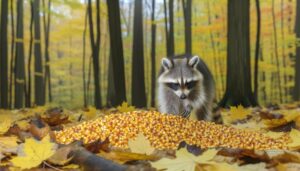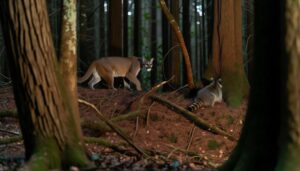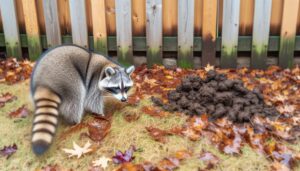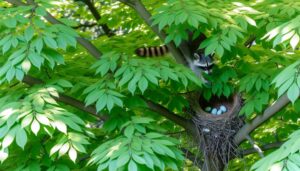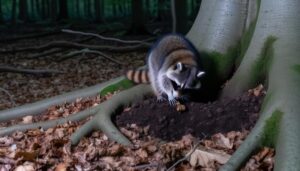Do Raccoons Eat Yellow Jackets?
Yes, raccoons do eat yellow jackets despite the potential risks. As highly opportunistic feeders, raccoons have a varied diet that includes insects like yellow jackets.
Their thick fur and quick paw reflexes help them handle stings effectively. Foraging primarily at night, raccoons can dig out yellow jacket nests, taking advantage of their high protein content.
This behavior demonstrates the raccoon's adaptability and complex problem-solving abilities. Understanding the dietary preferences and survival strategies of raccoons provides insight into their ecological role and interactions with other species, offering a deeper understanding of their impact on the environment.
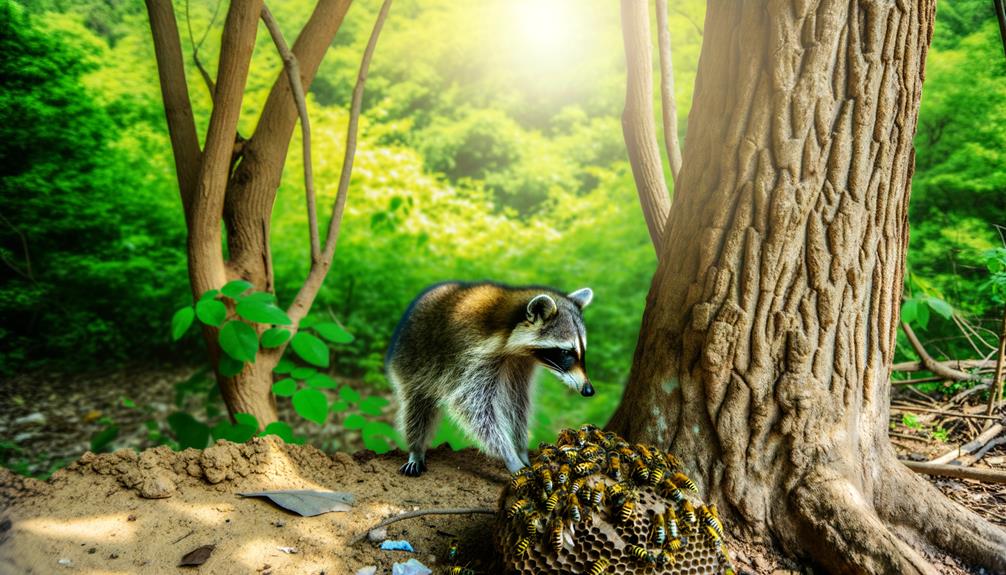
Key Takeaways
- Raccoons have been observed consuming yellow jackets as part of their opportunistic diet.
- Their thick fur and quick reflexes help raccoons manage yellow jacket stings.
- Raccoons' foraging adaptability includes eating insects like yellow jackets, especially when other food sources are scarce.
- Consuming yellow jackets provides raccoons with a protein source, despite the risk of stings.
- Raccoons' varied diet and problem-solving skills enable them to exploit yellow jacket nests.
Raccoon Dietary Preferences
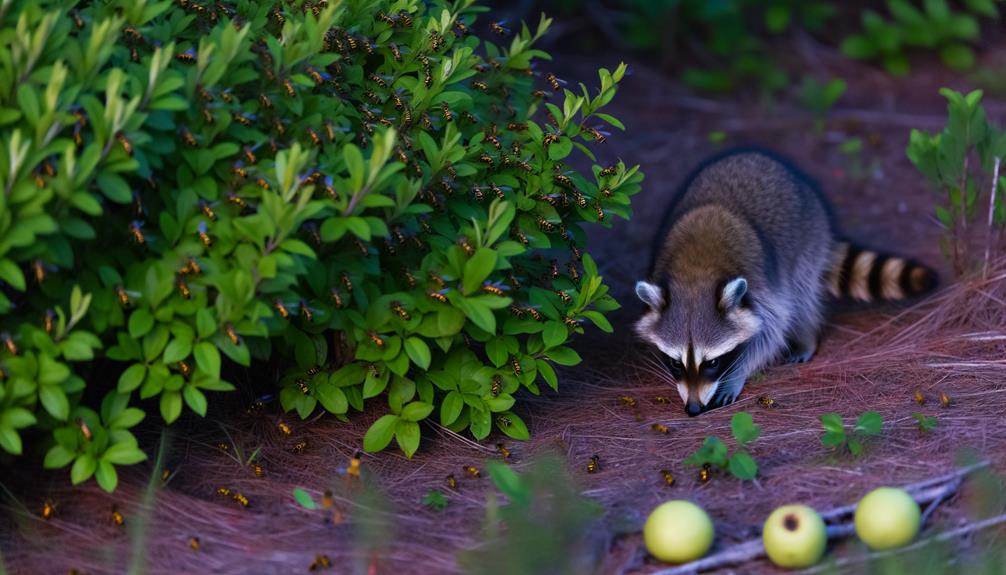
Raccoons are known for their highly opportunistic and varied diet, which includes fruits, nuts, small animals, and occasionally insects. Their dietary habits reflect their adaptability and resourcefulness in diverse environments.
Raccoons often scavenge for food, consuming whatever is readily available, which can range from plant material to animal matter. They have been observed eating bird eggs, fish, amphibians, and small mammals.
In urban settings, raccoons frequently raid garbage bins and pet food containers, showcasing their ability to exploit human-provided resources. Their omnivorous diet is not only a demonstration of their survival skills but also influences their role in various ecosystems, as they help control pest populations and contribute to seed dispersal.
Understanding raccoon dietary preferences provides insight into their ecological impact.
Understanding Yellow Jackets
Yellow jackets, members of the wasp family Vespidae, are known for their aggressive behavior and potent stings, which play an important role in their ecological interactions and defense mechanisms. These insects exhibit distinctive characteristics that merit closer examination:
- Nesting Habits: Yellow jackets build nests in various locations, including underground cavities and tree hollows.
- Diet: They are omnivorous, consuming nectar, fruits, and other insects, which makes them both predators and scavengers.
- Social Structure: Yellow jackets live in colonies with a strict hierarchy, including queens, workers, and males.
- Defensive Behavior: Their ability to sting multiple times without dying, unlike bees, makes them formidable defenders of their nests.
Understanding these facets provides a detailed view of yellow jackets' role in the ecosystem.
Natural Predators of Yellow Jackets
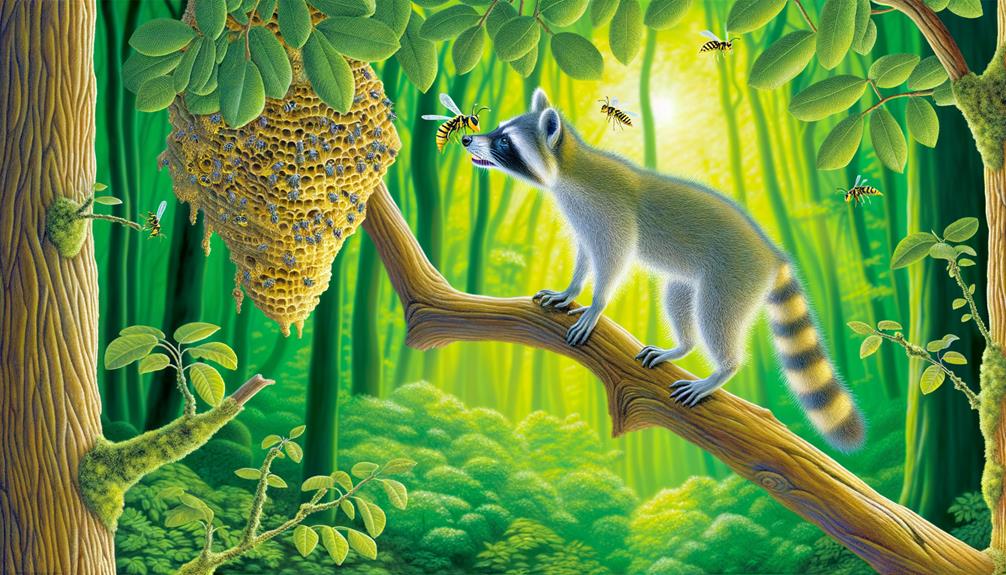
Natural predators of yellow jackets play an essential role in controlling their populations and maintaining ecological balance. Various bird species, spiders, and mammalian insect predators exhibit unique hunting strategies that effectively target yellow jackets.
Understanding these interactions provides insight into the complex dynamics of ecosystem regulation and pest management.
Birds and Yellow Jackets
Several bird species are known to prey on yellow jackets, contributing greatly to the natural regulation of their populations. These avian predators not only help control yellow jacket numbers but also maintain ecological balance.
Key bird species include:
- European Bee-eaters: These birds are adept at catching and consuming various wasps, including yellow jackets.
- Tanagers: Particularly the Summer Tanager, which specializes in eating bees and wasps.
- Bluebirds: Known to feed on a variety of insects, including yellow jackets, particularly during their nesting season.
- Sparrows: Certain species, like the house sparrow, have been observed consuming yellow jackets as part of their diet.
Understanding these natural predation mechanisms can provide insights into managing yellow jacket populations without relying heavily on chemical controls.
Spiders Hunting Wasps
The complex interplay between spiders and their prey includes numerous species that have evolved specialized behaviors to hunt yellow jackets effectively.
Especially, orb-weaver spiders construct intricately designed webs capable of ensnaring these agile wasps. Once captured, the spider delivers a venomous bite to immobilize the yellow jacket, mitigating the risk of being stung.
Other spider species, such as the bold jumping spider, employ a different strategy by using their superior agility and keen eyesight to ambush yellow jackets directly.
These predation methods not only highlight the spiders' adaptability but also contribute to the regulation of yellow jacket populations in their ecosystems.
Through these interactions, spiders play a critical role in maintaining ecological balance by controlling wasp numbers naturally.
Mammalian Insect Predators
Among the various natural predators of yellow jackets, several mammalian species exhibit specialized behaviors and adaptations that enable them to effectively hunt and consume these stinging insects. These adaptations range from physical traits to behavioral strategies, allowing mammals to mitigate the risks posed by yellow jackets.
Notable mammalian insect predators include:
- Raccoons: Utilizing their dexterous paws and intelligence, raccoons can dismantle yellow jacket nests with minimal stings.
- Skunks: Known for their robust immune systems, skunks dig up nests and consume larvae and adult wasps.
- Bears: With thick fur and tough skin, bears can endure stings while foraging for protein-rich larvae.
- Badgers: Equipped with powerful claws, badgers excavate underground nests to access yellow jackets.
These mammals play a critical role in controlling yellow jacket populations.
Raccoons as Opportunistic Feeders
Raccoons display highly adaptable feeding behaviors, consuming a diverse array of food sources available in their environment. This omnivorous diet includes fruits, vegetables, small mammals, fish, and human refuse, showcasing their remarkable ecological flexibility.
Their ability to exploit a wide range of food items is a reflection of their opportunistic nature, allowing them to thrive in both urban and rural settings. Seasonal variations also influence their dietary choices, with raccoons often shifting their focus based on food availability.
This adaptability not only aids in their survival but also contributes to their role as generalist foragers in various ecosystems. By capitalizing on whatever resources are at hand, raccoons effectively minimize the risks associated with food scarcity.
Insects in the Raccoon Diet
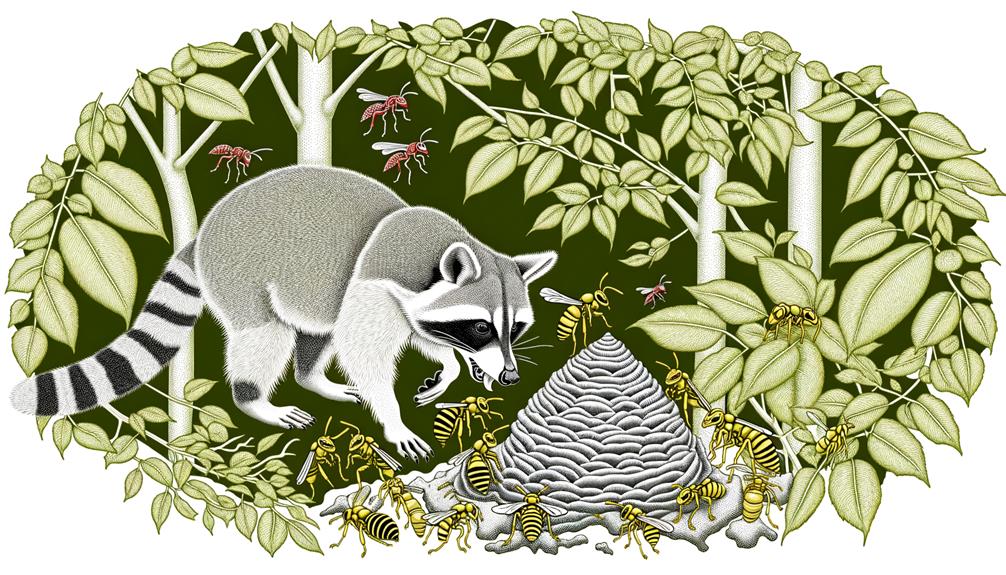
Insects form a significant portion of the raccoon diet, encompassing a variety of common prey such as beetles, ants, and grasshoppers.
These insects provide crucial nutritional benefits, including proteins and fats necessary for the raccoon's energy needs and overall health.
Raccoons exhibit specific foraging habits, often using their dexterous paws to uncover and capture these small but essential food sources.
Common Insect Prey
In their opportunistic feeding habits, raccoons frequently incorporate a variety of insects into their diet, exploiting the nutritional benefits these small creatures offer. The diversity of insects consumed by raccoons reflects their adaptability and foraging skills.
Among the most common insect prey are:
- Beetles – Rich in proteins and fats, beetles are a substantial dietary component.
- Ants – Easily accessible and often consumed in large quantities.
- Caterpillars – High in protein and relatively easy to catch.
- Grasshoppers – Providing a balance of nutrients and commonly found in various habitats.
This predilection for insects not only highlights raccoons' dietary flexibility but also their ability to thrive in diverse environments by exploiting readily available food sources.
Nutritional Benefits
A significant portion of the raccoon's diet consists of insects, which provide important nutrients such as proteins, fats, and various vitamins that are essential for their overall health and survival.
The high protein content in insects supports muscle development and repair, while fats serve as a dense energy source, important for maintaining the raccoon's active lifestyle.
Additionally, insects offer micronutrients like vitamins B and E, which play roles in metabolic processes and antioxidant functions. The nutritional profile of insects thus makes them a necessary component of the raccoon's diet.
Consuming a variety of insects ensures that raccoons obtain a balanced intake of these essential nutrients, contributing to their adaptability and resilience in diverse environments.
Foraging Habits
Raccoons exhibit highly adaptable foraging habits, frequently seeking out insects as a reliable food source across various habitats. Insect consumption offers essential nutrients and complements their omnivorous diet. Considering their opportunistic nature, raccoons are known to consume a wide variety of insects, including:
- Yellow Jackets: Despite their stings, yellow jackets are targeted for their protein-rich bodies.
- Beetles: These insects provide a substantial source of protein and are commonly found in raccoons' natural foraging areas.
- Caterpillars: High in protein and easy to catch, caterpillars are a frequent part of their diet.
- Grasshoppers: Abundant during certain seasons, grasshoppers offer a quick and nutritious meal.
These foraging habits underscore raccoons' ecological adaptability and dietary flexibility.
Foraging Behavior of Raccoons
Examining the foraging behavior of raccoons reveals their opportunistic and adaptable nature in securing diverse food sources. Raccoons exhibit a highly flexible diet, consuming anything from fruits and nuts to small mammals and aquatic organisms.
Their nocturnal foraging activities are characterized by a keen sense of touch and dexterity, allowing them to exploit various environments, including urban areas, forests, and wetlands.
This adaptability is facilitated by their highly developed cognitive abilities, which enable problem-solving and memory retention. Raccoons often scavenge human refuse, showcasing their ability to thrive in anthropogenic landscapes.
Their foraging strategies are influenced by seasonal availability and resource abundance, underscoring their resilience and ecological versatility. Such behaviors underscore their success as generalist feeders.
Risk Vs. Reward: Eating Yellow Jackets
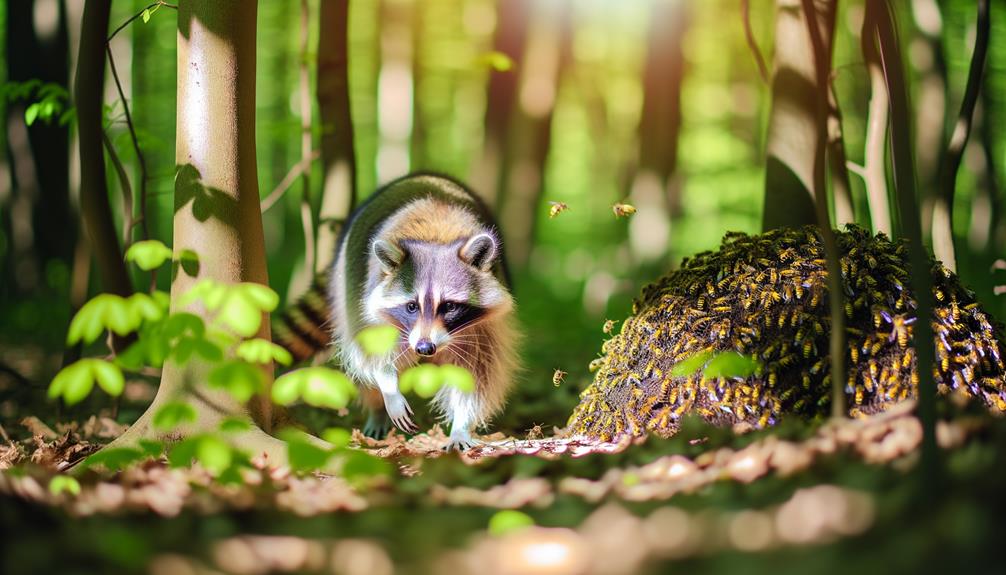
While the nutritional benefits of consuming yellow jackets may appeal to raccoons, the inherent risks associated with their aggressive nature and potent stings necessitate a careful evaluation of this food source.
Analyzing the risk versus reward involves several critical factors:
- Nutritional Value: Yellow jackets provide a rich source of protein and fat, essential for raccoons' dietary needs.
- Aggression and Stings: Yellow jackets' defensive behavior and venomous stings pose significant risks of injury and potential allergic reactions.
- Energy Expenditure: Hunting and consuming yellow jackets may require substantial energy, affecting the overall caloric gain.
- Alternative Food Sources: Availability of less risky and equally nutritious food options may influence raccoons' choice to avoid yellow jackets.
Understanding these factors helps in comprehending raccoons' foraging decisions.
Evidence of Raccoons Eating Yellow Jackets
Despite the inherent risks, documented instances of raccoons consuming yellow jackets provide valuable insights into their feeding behaviors and dietary adaptability. Field observations and anecdotal reports indicate that raccoons occasionally target yellow jackets, particularly during late summer and early fall when the insects are most abundant.
Examination of raccoon scat has revealed remnants of yellow jackets, suggesting intentional consumption. Moreover, wildlife cameras have captured raccoons foraging near or disturbing yellow jacket nests, supporting the premise that these mammals include the insects in their diet.
This behavior can be attributed to raccoons' opportunistic feeding strategies, which allow them to exploit various food sources in their environment, thereby enhancing their survival and resilience in diverse habitats.
How Raccoons Handle Stings
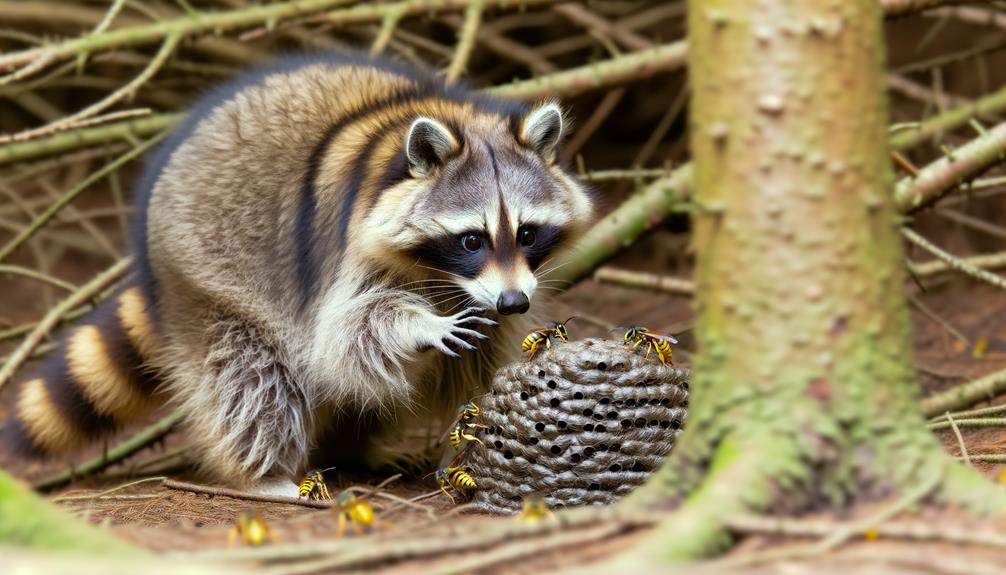
Raccoons exhibit several adaptive behaviors to manage yellow jacket stings effectively. Their thick fur acts as a natural barrier, minimizing the impact of stings on their skin. Their quick paw reflexes allow them to swat away insects rapidly.
Additionally, raccoons employ various sting resistance tactics, such as targeting nests during cooler temperatures when yellow jackets are less active.
Thick Fur Protection
The dense and coarse fur of raccoons provides an essential layer of protection against the stings of yellow jackets. This fur acts as a first line of defense, reducing the likelihood of stings penetrating to the skin. This natural armor is particularly effective due to several factors:
- Density: The thick fur traps air and creates a barrier, making it difficult for yellow jackets to reach the skin.
- Coarseness: The rough texture of the fur can dissuade yellow jackets from attempting to sting.
- Layering: Multiple layers of fur increase the difficulty for stingers to access the raccoon's vulnerable areas.
- Adaptation: Evolutionary adaptation has enhanced the protective qualities of raccoon fur over generations.
These factors collectively contribute to the raccoon's ability to handle yellow jacket stings effectively.
Quick Paw Reflexes
In addition to their thick fur, raccoons utilize their quick paw reflexes to deftly handle yellow jacket stings, showcasing a remarkable behavioral adaptation. These agile creatures possess highly sensitive and dexterous paws, allowing them to swat or dislodge yellow jackets with impressive speed and precision.
This rapid response minimizes the duration and frequency of stings, reducing potential harm. Observational studies indicate that raccoons often engage in swift, deliberate movements to neutralize the threat posed by these insects. Their reflexes are not only a defensive mechanism but also an effective strategy for accessing the protein-rich larvae within yellow jacket nests.
This adaptation underscores the raccoon's ability to exploit a challenging food source while mitigating the associated risks.
Sting Resistance Tactics
Employing a combination of physical adaptations and learned behaviors, raccoons exhibit several effective sting resistance tactics to mitigate the impact of yellow jacket stings. These tactics enable raccoons to prey on yellow jackets with minimal risk.
Key strategies include:
- Thick Fur and Skin: Their dense fur and relatively tough skin act as a natural barrier, reducing the likelihood of stings penetrating deeply.
- Agility and Quick Movements: Raccoons use rapid, agile movements to dodge attacks, minimizing the chances of being stung.
- Targeted Attacks: They focus on incapacitating yellow jackets by targeting the insects' nests, reducing the number of active defenders.
- Behavioral Learning: Through experience, raccoons develop techniques to handle and consume yellow jackets while avoiding stings.
These adaptations illustrate their resilience and resourcefulness.
Seasonal Eating Habits
Raccoons exhibit distinct seasonal eating habits, driven by the availability of various food sources throughout the year. In the spring, they often consume insects, small mammals, and newly available plant matter.
Summer diets typically include fruits, berries, and occasional amphibians or bird eggs, capitalizing on the season's abundance.
As autumn approaches, their focus shifts to high-calorie foods like nuts and seeds, essential for building fat reserves in preparation for winter.
Winter months see raccoons becoming more opportunistic, relying on cached food and scavenging due to reduced availability. This seasonal adaptability is vital for their survival, as it allows them to exploit diverse resources and cope with fluctuating environmental conditions, ensuring a stable energy supply year-round.
Comparisons to Other Animals
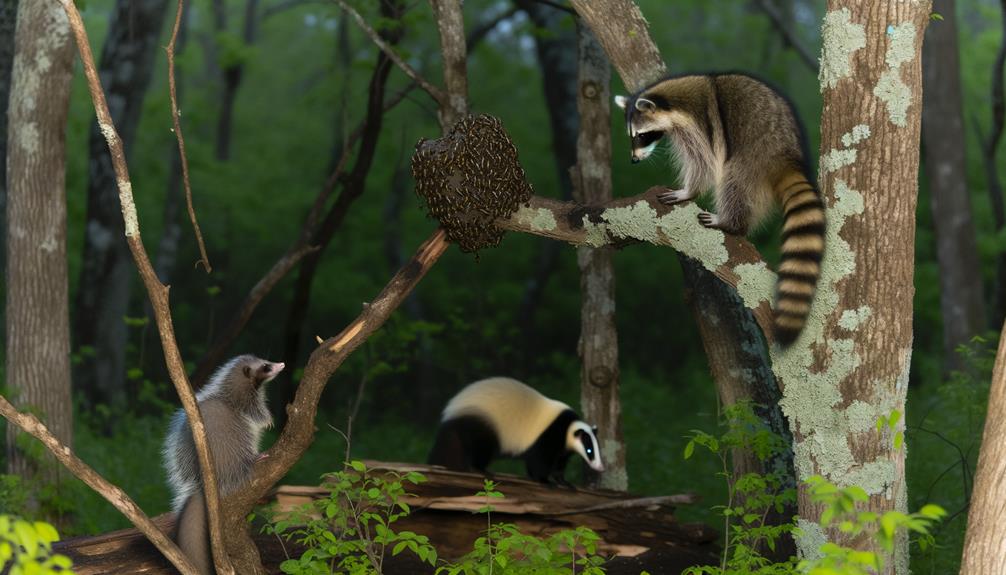
When comparing the dietary habits of raccoons to those of other omnivorous animals, notable differences and similarities emerge, reflecting their unique ecological niches and adaptive strategies. Raccoons, like other omnivores, exhibit a flexible diet that allows them to exploit a variety of food sources depending on availability.
However, specific preferences and behaviors set them apart from other omnivores such as bears, foxes, and opossums.
- Raccoons: Known to eat insects, fruits, small mammals, and occasionally, yellow jackets.
- Bears: Primarily consume berries, fish, and insects, but rarely target specific insects like yellow jackets.
- Foxes: Focus on small mammals and birds, with insects forming a minor part of their diet.
- Opossums: Highly opportunistic, consuming fruits, insects, and small vertebrates, including occasional wasps.
Enhancing Your Backyard for Wildlife
Creating a wildlife-friendly backyard involves strategically incorporating native plants and habitat features that provide food, water, and shelter for various species. Native flora attracts insects and animals adapted to local conditions, thereby supporting biodiversity.
Water sources such as birdbaths or small ponds cater to drinking and bathing needs. Diverse vegetation layers, from ground cover to canopy trees, offer varied nesting and foraging opportunities. Log piles, rock gardens, and leaf litter create microhabitats for insects and small mammals.
Minimizing pesticide use is essential, as chemicals can disrupt local ecosystems. Providing birdhouses, bat boxes, and feeders can further enhance habitat options. These measures collectively create a balanced environment, encouraging a plethora of wildlife to thrive in your backyard.
Conclusion
To sum up, raccoons exhibit diverse dietary preferences, including occasional consumption of yellow jackets. As opportunistic feeders, raccoons adapt to available food sources, incorporating insects into their diet. While natural predators of yellow jackets are varied, raccoons handle stings effectively, showcasing their resilience.
Seasonal eating habits influence raccoon foraging behavior, leading to a broader comparison with other animals. Enhancing backyard habitats can support wildlife, promoting a balanced ecosystem. Raccoons' dietary adaptability underscores their ecological significance and survival strategies.


